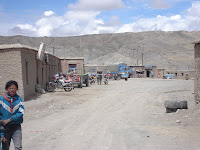
All that remains of the splendor that Drathang once clearly had been is the skeleton of a single building. The surrounding complex is gone, the upper two floors of the lone surviving building lie in ruins, and the ground floor itself is far from intact. Its walls bear the painful scars of attacks made under the communist regime. In the places where a magnificent Buddha statue and eight bodhisattvas once stood today one finds bare patches of plaster, a series of halos marking the sanctity of heads that have long been gone, and bits of gilded throne protruding from the wall high overhead.

But what does survive stuns the viewer not only with its beauty but with the clarity of its vision. Between the long slashes of damage are among the most staggering murals we will see on our month-long tour of Tibet’s best preserved artistic treasures.

Viewing art in religious buildings is fundamentally unlike viewing it in museums or secular establishments. Looking at such art in situ, viewers are necessarily placed in the position adopted by the centuries of pilgrims and religious practitioners who had interacted with the art, gazing at it with awe and delight, making offerings to it with admiration or supplication, or simply opening themselves to the blessings and power of its presence.

To the degree that the artist expressly conceived the work with an audience in mind, the art will consciously heighten these responses. Exploiting features of perspective, lighting, composition or simply scale, the art itself anticipates and shapes the way viewers will relate to what they perceive.
Drathang’s wall paintings seem singularly designed to address its viewers. Here the art works on its audience not by the size of its scale but by the composition of a gathering of disciples around the Buddha. The painters clearly envisioned a highly diverse assembly gathering around the Buddha as he taught. An improbable range of ethnic types and colors crowd together around the Buddha, with yellow, red, green, blue and white monks, bodhisattvas, lay followers visually marked as Tibetan, central Asian, Indian, Chinese … Figures are positioned almost huddling together as if trying to draw as close to the Buddha, and the vibrancy of this gathering is palpable. Unlike some depictions of the Buddha as he teaches, not all figures face the Buddha, and not all sit in calm and attentive repose. Instead, the panel is teeming with energy and individuality, with some members of the assembly exchanging smiles of delight, some with eyes wide in amazement and others with their gaze focused intently on the Buddha.

A few even appear with their hands in teaching position, apparently commenting to one another on what they are hearing. Even the snow lions below the throne seem caught up in the excitement of the moment, as the artist has pictured them scratching themselves.

Standing before this centuries-old vision of the Buddha and his audience, I suddenly notice that several of the figures in this audience are staring straight out at me, the viewer. In this instant, the artist’s work has reached out to include me in the assembly. Just as some monks in the gathering around the Buddha were exchanging looks, here these bodhisattvas are now exchanging looks with those of us who have joined the assembly in the temple all these centuries later.

In this instant, I as viewer am given a place in the assembly. The range of diversity that the Buddhists of that era in Tibet envisioned as part of their community expands just a bit, to include an American nun who is among those smiling as she gazes at the Buddha and exchanges glances with the bodhisattvas also part of the assembly.

Most of these exquisite photos were taken by my wonderful traveling companions Wen-Shing Chou and Christian Luczanits.

All
 during our day at sakya, we stumbled across a relatively modest group of monks debating in the courtyard outside one of the main halls.
during our day at sakya, we stumbled across a relatively modest group of monks debating in the courtyard outside one of the main halls. 
















































